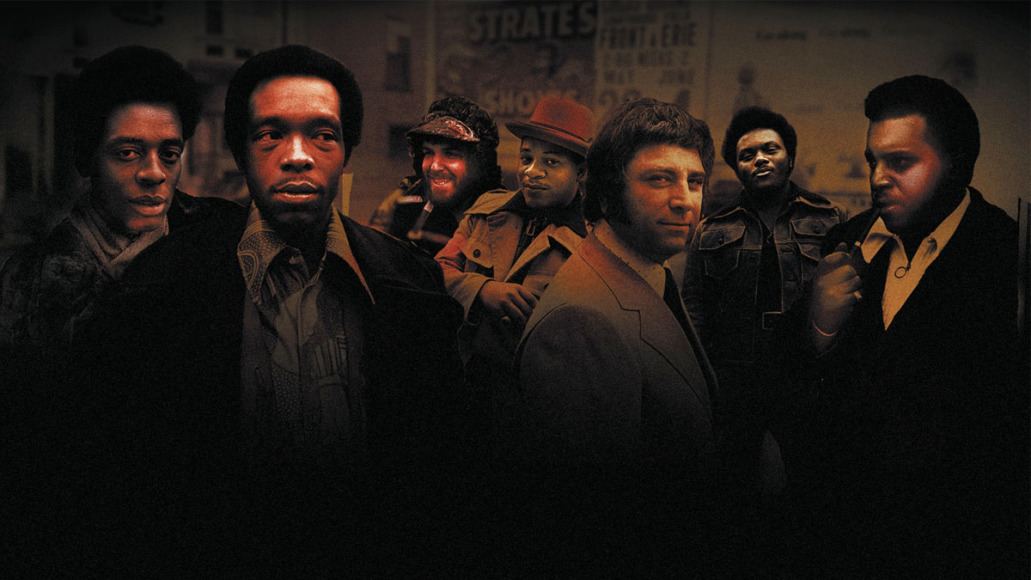
Thanks to MFSB, Love Is Still the Message 47 Years Later: Classic Review
June 10, 2021 | 11:15am ET
You can’t really discuss the soul music of the ‘70s without referencing Philadelphia International Records, and you can’t know Philly International if you aren’t familiar with MFSB. The music of Philadelphia International Records is part of the fabric of American music, and the heart of that sound was the label’s famed house band.
Short for “Mother, Father, Sister, Brother,” the group of seasoned studio musicians gave artists like Billy Paul and Harold Melvin & The Blue Notes that sterling, sweeping backdrop — elevating the scope of soul music arrangements while also providing the life blood for disco.
MFSB was a cadre of more than thirty musicians who would record hits for Philadelphia International Records. They came together at Sigma Sounds in Philadelphia, recruited by P.I.R’s songwriting/production moguls Kenny Gamble & Leon Huff — who launched Philadelphia International Records in 1971 — and Thom Bell.
The core of the group began as the backing band for Cliff Nobles & Co.; Norman Harris, Bobby Eli, Ronnie Baker and Earl Young backed Nobles on his single “Love Is All Right” and scored an uncredited dance hit with “The Horse” in 1968. “The Horse” became a Philadelphia dance craze that summer, and the musicians found themselves in demand, backing singers like The Fantastic Johnny C and briefly christening themselves “The James Boys” as the backing group for Jesse James.
Over time, MFSB would coalesce around the talents of drummer Young, bassist Baker, guitarist Harris, and percussionist Vincent Montana, Jr. with Karl Chambers and Norman Fearrington also joining as drummers; T.J. Tindell, Roland Chambers and Eli on guitar, and Winnie Wilford contributing on bass. Soon, percussionist Larry Washington, saxophonist Zach Zachary, organist/keyboardist Lenny Pakula, and drummers Miguel Fuentes and Quinton Joseph joined the fold.
Labels like Motown in Detroit and Stax Records in Memphis had legendary session musicians in The Funk Brothers and Booker T. and the M.G.’s, respectively. As compared to their predecessors, MFSB stood out due to the size of the collective and the lush smoothness of their sound. At Motown, the Funk Brothers mostly toiled in anonymity, never releasing an album under their own name. Booker T. and the M.G.’s didn’t have that problem at Stax, but they were a set quartet of neighborhood friends, not the massive collective of musicians MFSB would assemble.
It was the distinct hi-hat of Young that propelled hits by artists like The O’Jays and Harold Melvin & the Blue Notes, as well as non-label acts such as The Stylistics. The rhythm section of MFSB was especially potent and influential, providing Latin-inflected proto-disco grooves for hits like “I Love Music” and “The Love I Lost.”
In 1973, MFSB released their eponymous debut album, a jazzy collection of instrumentals that established the group. The album’s liner notes were a clear attempt to make sure the musicians got showcased in their own right; full credit was given to each band member, with photos on the back sleeve, and notes by music columnist G. Fitz Bartley. The project featured the band tackling popular hits by Curtis Mayfield (“Freddie’s Dead”) and Sly Stone (“Everyday People”) but its real jewel was “Something For Nothing,” a song that became something of a Hip-Hop staple in the ‘90s and 2000s, sampled by artists like Jay-Z and Jeru Da Damaja.
Still, it was MFSB’s second album that pushed the band into the spotlight. Love Is the Message would see release in 1974, and the title track would become a popular late ‘70s block party mainstay in New York City, while another of the album’s tracks would become the group’s first hit single. “(TSOP) The Sound of Philadelphia,” a Gamble-and-Huff penned instrumental groove, would serve as the theme song for Soul Train, a new hit dance show created by Don Cornelius in Chicago.
Advertisement
“Love Is the Message” wouldn’t be the major chart hit that “TSOP” became, but its legacy is just as indelible. It opens with that distinct hi-hat and a gorgeously stirring string arrangement, with a blast of horns over the top of some truly stunning guitar and Hammond organ work from Lenny Pakula.
Saxophonist Zach Zachary cuts through as the song’s pulsing rhythm kicks in, grooving somewhere between midtempo and uptempo. It alternates between those soaring strings and drops down into pulsing disco, with Montana’s unmistakable vibes adding color throughout. It’s a perfect example of the musical potency of MFSB, along with Gamble & Huff’s songwriting and the arrangements of Bobby Martin.
Advertisement
“Love Is the Message” would remain a staple on Black radio for most of the 1970s, and decades later, it would be frequently sampled; turning up on tracks by everyone from EPMD (“It’s Time To Party”) to LL Cool J (“Def Jam In the Motherland“) and Cappadonna of Wu-Tang Clan (“Love Is the Message”) and perhaps most notably, The Jungle Brothers “What U Waitin’ 4.”
The album’s remaining covers are just as riveting and perfect examples of the collective’s strengths: a jazzy rendering of Johnny Taylor’s “Cheaper To Keep Her”; saxophonist Zach gets a sterling showcase on “My One and Only Love,” and MFSB’s rapturous take on the Diana Ross staple “Touch Me In the Morning” is one of the best pieces they ever recorded. Even the sax-laden “Zach’s Fanfare” is exhilarating.
Album closer “Bitter Sweet,” written by Bruce Hawkes and Jack Faith, features tremendous arranging polish from Faith. He was often the unsung hero at Philly International, and this track showcases why we should all mention his name more often. With unexpected tempo shifts, beautiful rhythm work from Young and Baker, and a spectacular vibes performance from Montana, it proves he deserved billing with the label’s big guns.
Advertisement
Love Is the Message would become MFSB’s most successful album. Along with the band’s two most popular hits, it featured distinct artwork that almost ran counter to the polished, smoothness of the music. The cover features a human skull wearing a military helmet, along with a swastika, a dog, a mushroom cloud, and a Klansman among the images. It speaks to the ethos of MFSB, Philly International and Gamble & Huff: love is the message in the face of a dark and increasingly insane world. It was and remains a beautiful sentiment and a testament to the spirit of Black music.
In terms of the relationship between MFSB and P.I.R., things were beginning to fray. The band’s mainstays were becoming frustrated with their relative anonymity and lack of ownership of their music. Despite their faces being prominently featured on back sleeves of their first two albums, Philly International wasn’t as diligent about making sure they were highlighted on subsequent releases.
MFSB was getting tired of languishing in the shadows of soul superstars. Baker, Harris, and Young had established their own publishing house in 1973, and they began working on building their own catalog, all while still recording for Philly International. The Philly Groove label released albums by First Choice like 1973’s Armed and Extremely Dangerous and 1974’s The Player.
By 1975, Montana was eyeing a move to another label. SalSoul was making noise with albums by poet/singer-songwriter Gil Scott-Heron, and was actively recruiting Montana to the label. Co-founder Ken Cayre attracted Fontana as well as Harris, Baker and Young to the label in 1976 and rechristened the band The SalSoul Orchestra.
“First thing I did was that I went up to Philadelphia because all the records that I liked, I use to look on the back to see who the musicians were and they were all from Philadelphia,” Cayre explained in 2004. “I found out that there was one set of musicians that were recording the rhythm section for all these groups and I tracked them down — they were Earl Young on drums, Ronnie Baker on bass, Norman Harris on guitar, Bobby Eli on guitar, Bunny Sigler on keyboard, Ron Kersey on keyboard, there was Vince Montana Jr. on vibes and Larry Washington on the congas.”
This was the sound Cayre was seeking in order to start the SalSoul label. “I went to Philadelphia and I met Vince Montana there,” he continued. “I told him of my idea to do an instrumental and calling the group the SalSoul Orchestra, which I was naming the label. We recorded three songs, one of them was the ‘SalSoul Hustle.’”
The debut album from the Salsoul Orchestra was released in late 1975, just weeks before the release of the final Philly International albums to feature the original MFSB: The O’Jays’ Family Reunion and Harold Melvin & the Blue Notes’ Wake Up Everybody. Universal Love, the final MFSB album to feature Montana, Baker and Young, was also released that year.
The album features the band in full disco mode, highlighting the sound that would come to define the second half of the 1970s. The remainder of the band would team with producer Dexter Wansel for more disco hits as the decade wound down, and MFSB made a noteworthy appearance on the Saturday Night Fever soundtrack with a cover of the Nite Lighters’ 1971 hit “K Jee.” MFSB released their final album in 1980 before quietly disbanding a year later.
The musicianship of all involved with MFSB, the standard of excellence that the band created, and what that legacy means to Philadelphia soul; it’s part of an indelible trail blazed by a collective of ambitious instrumentalists. Philly soul was the sound of Blackness bursting out of the Civil Rights era and daring to be bright and optimistic even against a backdrop of ongoing racial conflict and economic unrest.
With songs like “Love Is the Message” and “TSOP,” Mother Father Sister Brother embraced the idea of music as a great connector for people. The familial name is more than appropriate; this was the sound of kinship and togetherness. It was more than the sound of young America; it was the soul of Black folks.
Essential tracks: “Love Is the Message”, “TSOP (The Sound of Philadelphia)”
Love Is the Message Artwork:

